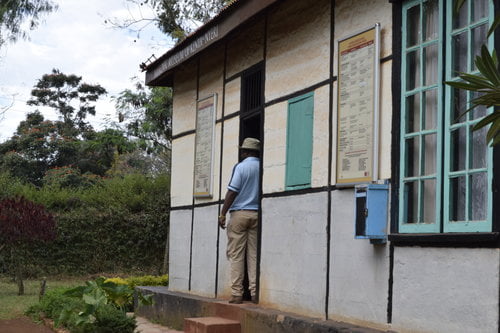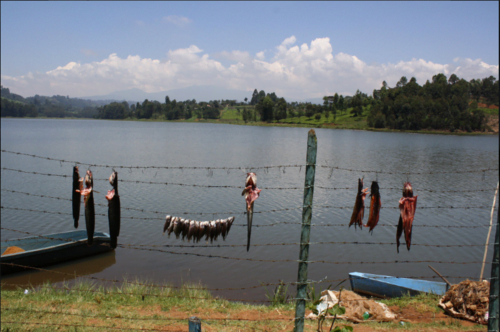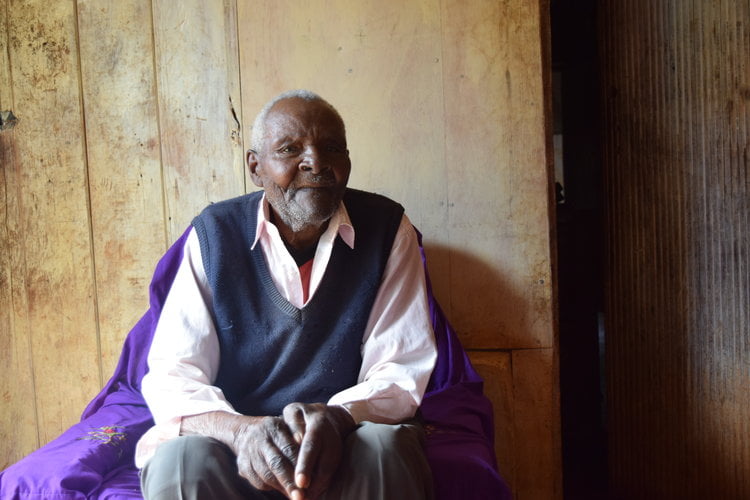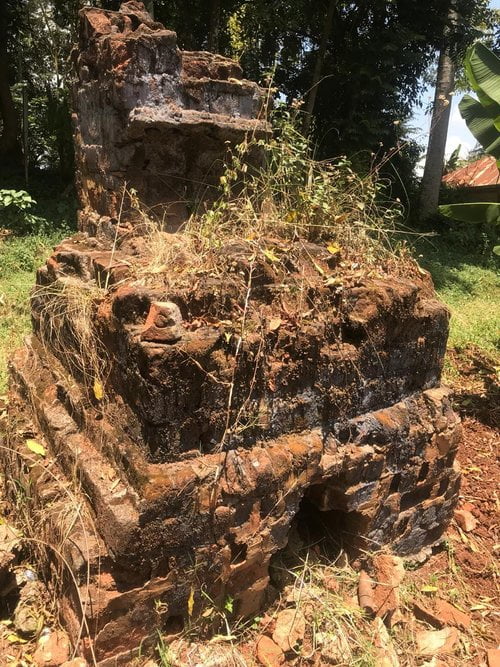As you may have seen on our social media, our team recently visited Kenya to conduct field research on the remains of Mau Mau detention centres. This work builds upon the archival research and work on digital maps of the ‘Pipeline’ that we’ve previously undertaken. Our work in Kenya was supported by the UCL Centre for Critical Heritage Studies, as well as National Museums Kenya, and of course our Kickstarter backers.
Our aim was to survey the remains of these colonial detention centres and work camps, in the hopes that a study of such sites would illuminate the lives of prisoners (and their captors) during the Mau Mau Emergency, and the technologies of structural violence employed. We wanted to record and preserve this archaeological heritage, ultimately with the aim of improving understanding of Kenya’s colonial history in both Kenya and the UK.

Anthony Maina outside Nyeri Museum
Our four days in the field began in Nyeri County, where six known work camps were located, including Aguthi and Mweru. To prepare for our research, we met with Anthony Maina of National Museums Kenya, whose knowledge and help guiding the team around Nyeri was invaluable. With Anthony, we visited the Nyeri Museum and the Mau Mau flag site (also see Beth’s blog on her visit to the site with Adam). The museum, housed in a former ‘native law court’, is filled with artefacts of the Emergency, including colonial shields and helmets, bricks produced by detainees in Aguthi Works Camp, and colonial ‘Pass Books’.
On the trail of Nyeri’s detention camps, our first day of field research was in Tetu, where some remaining structures of Aguthi Works Camp are now part of Kangubiri Girls School. Kangubiri is one of very few locations where the physical remains of the camps are still standing, including cells, torture chambers, and offices. Camps like Aguthi were the last stage of the ‘Pipeline’, and were known as ‘rehabilitation’ camps, a term that Beth recently unpacked on our blog. In a camp like Aguthi, colonial officers could determine whether a detainee was eligible to be released back into ‘society’, something that depended on the confession of allegiance to and renunciation of the Mau Mau. released back into ‘society’. It is said that this is where Kangubiri School gets its name: a Kikuyu modification of the English “Can go f\Free.” Trenches surrounding the camp – dug by detainees – are also still visible, the largest being 20ft wide and 10ft deep.
Later on in the day we met with Mr. Wambugu Nyigi, 91, a Mau Mau veteran who survived several camps around the country, and even the Hola massacre. It was a privilege to be able to listen to his story and to meet such a warm man so eager to help with our research. We were able to conduct an interview with him on his experiences during the Emergency; the oral history of Mau Mau veterans and survivors of the Uprising are as critical in preserving this history as the physical remains of the camps. (You can also read Mr. Wambugu’s story online here).
The surviving brick-making kiln from Mweru Works Camp
The following day we visited Mweru Works Camp in Mukuruweini, the buildings of which had again been repurposed for a high school. Mweru was known by the British colonial government as a ‘filter’ camp; a codename for places that used officially sanctioned violence. Still remaining at Mweru is a brick kiln. Detainees were forced to make the bricks used to build the camp structures, which included cells and a torture room, used for the administration of the ferocious ‘dilution techniques’ – a new method for ‘breaking’ the most hardcore Mau Mau.
After Mweru we travelled to Karunaini, where Dedan Kimathi was shot, and today serves as the site of his memorial. While there, we were lucky enough to meet and interview Mr. Wangobe, who carried Kimathi after the shooting. We also met an elderly gentleman, who as a young boy was one of the first to arrive on the scene after hearing gunshots from a nearby village, and told by the homeguards to build Kimathi’s stretcher.

Chinga Dam today (From Gabe’s Twitter thread)
Our final day of field research took us to Chinga Dam, which was constructed in the 1950s for a colonial officer who wanted a lake on which to sail and fish. Prisoners from Othaya Works Camp were forced to build the dam, destroying land belonging to local farmers who received no compensation. The construction of dams has a long history of being a brutally effective way to appropriate land, exploit resources, and destroy communities. Today, however, the lake has become a resource for the local community, where they can fish and rent out boats to tourists.
To see such a large amount of surviving infrastructure, to interview veterans and record their stories, and learn more about the ways in which local communities are dealing with the legacies of British colonial rule was remarkable. These experiences certainly made it easier to understand and put into context the stories we’ve read and memories we’ve heard. The research we’ve collected on this trip is invaluable to sharing the true nature of colonial history in Kenya, and we’re immensely grateful to all those who have helped us to gather this information, and especially to those who shared their experiences with us.
More updates soon!

